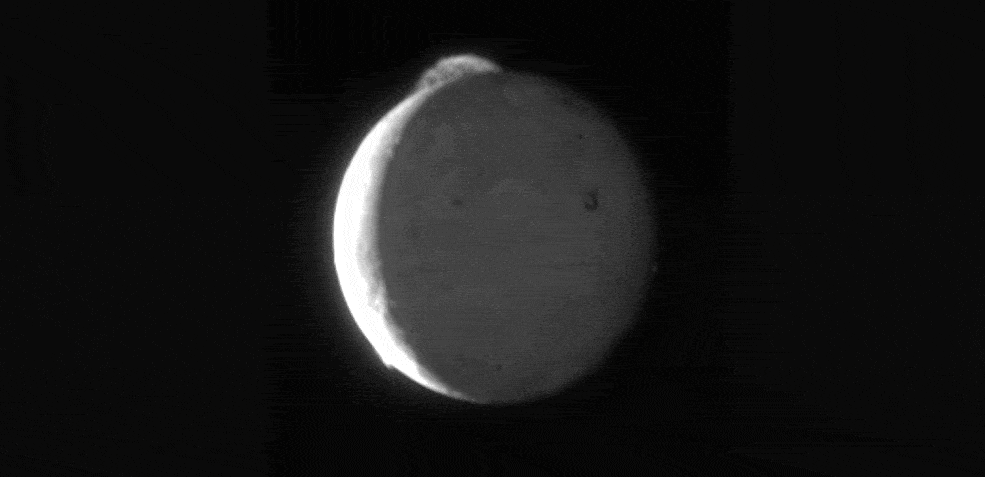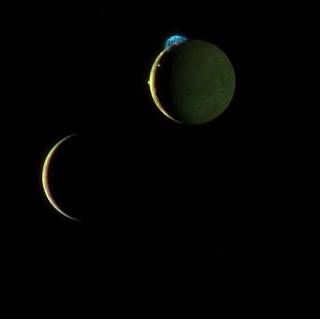An ocean of magma could explain why Jupiter’s moon Io has volcanoes in the “wrong place”. This would also mean that Io has an ocean of liquid water beneath its surface and might be potentially habitable. NASA’s research also suggests that this type of tidally stressed moon might be more common than previously thought.

This five-frame sequence of images from the New Horizons spacecraft captures the giant plume from Io’s Tvashtar volcano.
Credits: NASA/JHU Applied Physics Laboratory/Southwest Research Institute
“This is the first time the amount and distribution of heat produced by fluid tides in a subterranean magma ocean on Io has been studied in detail,” said Robert Tyler of the University of Maryland, College Park and NASA’s Goddard Space Flight Center in Greenbelt, Maryland. “We found that the pattern of tidal heating predicted by our fluid-tide model is able to produce the surface heat patterns that are actually observed on Io.”
Tyler is lead author of a paper on this research published June 2015 in the Astrophysical Journal Supplement Series.

The 300-kilometer (190-mile) high plume from the Tvashtar volcano is at the 11 o’clock position on Io’s disk, with a smaller plume from the volcano Prometheus at the 9 o’clock position on the edge of Io’s disk, and the volcano Amirani between them along the line dividing day and night.
Credits: NASA/JHU Applied Physics Laboratory/Southwest Research Institute
Io is the innermost of the four Galilean moons of the planet Jupiter. It is the fourth-largest moon, has the highest density of all the moons. It’s also the driest place in the solar system, and has extremely active volcanoes. This extreme geologic activity is the result of friction generated within Io’s interior as it is pulled between Jupiter and the other Galilean satellites—Europa, Ganymede and Callisto, which are much smaller, but also closer. The volcanoes are so massive that they spew out lava up to 250 miles (about 400 kilometers) high.
Previously, it was thought that this heat interacted with Io as a solid, but deformable body – much like clay. However, when scientists compared computer models using this assumption to a map of the actual volcano locations on Io, they discovered that most of the volcanoes were offset 30 to 60 degrees to the East of where the models put them – and this came as a complete surprise. The pattern was consistent throughout the entire lunar surface, which meant it was more than just a coincidence. Something more was involved.
“It’s hard to explain the regular pattern we see in so many volcanoes, all shifting in the same direction, using just our classical solid-body tidal heating models,” said Wade Henning of the University of Maryland and NASA Goddard, a co-author of the paper.
The enigma called for another explanation, one that had to do with heat transfer and fluid dynamics.
“Fluids – particularly ‘sticky’ (or viscous) fluids – can generate heat through frictional dissipation of energy as they move,” said co-author Christopher Hamilton of the University of Arizona, Tucson. The team thinks much of the ocean layer is likely a partially molten slurry or matrix with a mix of molten and solid rock. As the molten rock flows under the influence of gravity, it may swirl and rub against the surrounding solid rock, generating heat. “This process can be extremely effective for certain combinations of layer thickness and viscosity which can generate resonances that enhance heat production,” said Hamilton.
This would have implications not only for Io, but for all similar moons, in terms of extraterrestrial life. It’s already confirmed that Europa has a subsurface ocean, and this raises new possibilities for other moons.
“Long-term changes in heating or cooling rates within a subsurface ocean are likely to produce a combination of ocean layer thickness and viscosity that generates a resonance and produces considerable heat,” said Hamilton. “Therefore the mystery may be not how such subsurface oceans could survive, but how they could perish. Consequently, subsurface oceans within Io and other satellites could be even more common than what we’ve been able to observe so far.”









